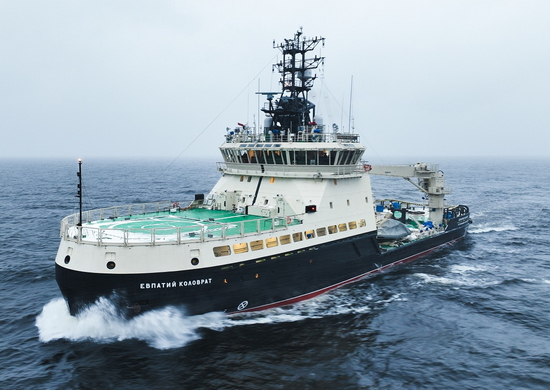 Icebreaker Evpatiy Kolovrat from the Russian Navy
Icebreaker Evpatiy Kolovrat from the Russian Navy
Implications of Russia and China’s Developing Arctic Partnership
Earlier this month, Russian state agency Rosatom signed an agreement to build a year-round shipping lane through the Northern Sea Route (NSR) and to construct five ice-class vessels with the Chinese shipping line Hainan Yangpu NewNew Shipping. The deal will increase voyages on the Arctic Circle route from 7 to 12 by the end of the year, offsetting trade suspensions between Europe and Russia. Russia and China’s partnership forces the question of how the United States and Nordic allies can improve their economic competitiveness in the Arctic too.
Global shipping has been disrupted by Red Sea Houthi activity, the war in Ukraine, and the Panama Canal drought, prompting shipping companies to consider alternatives. For East Asian countries and northern China, the Asian-European shipping route via the NSR is becoming increasingly attractive as the Arctic becomes easier to navigate and trade grows between the two regions. Halted trade between Europe and Russia due to the war in Ukraine has made shipping exports such as liquified natural gas from northern ports more practical as Russian authorities control around 70 percent of the NSR, about 70 percent of the Arctic, and 53 percent of the Arctic Ocean coastline.
The Russo-Ukrainian war coupled with Sweden and Finland’s new status as NATO members makes Russia the only non-NATO Arctic country, further isolating it from the West. These circumstances have prompted Russia to pursue a closer alliance with China to maintain its influence in the Arctic Sea. This benefits China, which has wanted to develop the “Polar Silk Road” since it was first discussed in 2017, hoping to capitalize on potential mineral extraction and maritime transportation. In 2020, 48 new Chinese-owned companies registered to operate in the Arctic and that number rose to 123 by 2023, with a total of 359 Chinese-owned companies registering to operate in the Arctic in just over three years.
While the United States continues to demonstrate Arctic military competence, hosting a Department of Defense dialogue regarding Arctic security in January and participating in defense exercises of NATO’s northern flank with Finland, Norway, and Sweden in March, it lags in the economic sector. Russo-Chinese cooperation is superior in terms of infrastructure investment that would make Arctic exploration easier. The U.S. Coast Guard reports a shortage of icebreaker ships, which are essential to performing Arctic research and rescue missions, especially in newly available waters for fishing and transit. The United States only has two working icebreakers, of which one is dispatched to Antarctica. Conversely, Russia has more than 50 icebreakers and China unveiled its 4th icebreaker last December. Besides expanding the U.S. fleet of icebreakers, there needs to be better maritime infrastructure to support vessels navigating long distances in harsh conditions.
Nevertheless, showcasing military readiness does not compensate for the lack of prioritizing economic development. The Arctic is a zone of great economic importance for the United States to collaborate with Canada and Nordic European allies. The Bering Sea alone provides the United States with 60 percent of its fisheries, not to mention substantial oil and natural gas revenue. There is also potential for mineral extraction should the United States partner with Nordic allies. Recently, Norway announced its intentions to invest in deep seabed mining off of its continental shelf due to the presence of crusts containing metals and minerals that are crucial for making batteries, wind turbines, PCs, and mobile phones.
Besides improving infrastructure, building more icebreakers, and increasing cooperation with Nordic allies, the United States should also ratify the United Nations Convention on the Law of the Sea (UNCLOS). This treaty defines the international parameters for managing all marine and maritime activities. Pressuring other countries to abide by the treaty despite not ratifying it creates distrust with the United States. Ratification of the UNCLOS would strengthen U.S. maritime policy and influence abroad as well as legitimize territorial claims.
Whether Russia and China’s partnership over the thawing Arctic results in a significantly fruitful trading route remains to be seen. Nevertheless, the United States needs to recognize the importance of economically investing in the Arctic seas in collaboration with its Nordic allies to not cede domination of the region to Russia. By properly delineating and taking advantage of coastal borders, the United States and its allies can better secure its economic interests.






